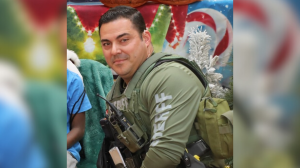
South Gulf Cove unites for Sgt. Diaz with heartfelt fundraiser event
The South Golf Cove community came together for a special cause, hosting a first responder event to honor the late Sgt. Elio Diaz.

Steps from the Caloosahatchee, Lily Manibo’s home suffered extensive damage from Hurricane Ian.
We had to rip up all the floors and half the walls,” Manibo said.
Stormwater flooded her house and yard, covering everything in slippery sludge.
“It was just all mud and just debris,” Manibo said.
One day after the storm, Lily was helping clean up when she became another statistic.
“There was a huge like ceramic planter pot and I just tripped over it and cut my Achilles straight through,” she said.
She went to one of Lee Health’s hospitals. Hers was one of the thousands of storm-related visits.
More than four months after Hurricane Ian and there is a clear picture of the physical toll it took on people who lived through it.
“We’re talking significant numbers,” said Dr. Timothy Dougherty, medical director disaster preparedness at Lee Health.
ER doctor Dougherty was working at the Cape Coral Hospital when Ian hit.
He said patients flooded in as soon as the weather allowed.
“We had over 100 patients sign in within the first few hours,” Dougherty said. “Just as the patients ascended into the emergency department. We actually had most of the medical staff and hospital staff descend down to the emergency department to help.”
The volume of patients they might see in one day showed up in a few hours.
WINK News asked for records from Lee Health’s six emergency rooms and analyzed the numbers looking at types of injuries and ailments to get a snapshot of exactly what happened.
There were 2,904 ER visits in the month following Ian at Lee Health’s five hospitals, plus the free-standing emergency room at Coconut Point.
Most went to Cape Coral Hospital.
The data doesn’t include whether they are a result of the hurricane, but the numbers tell a story.
The Cape ER recorded 824 patient interactions in the four weeks from Sept. 28 to Oct. 28,
That’s 307 more than the same period in 2021, which was during COVID when ER visits were already high.
In data reviewed by WINK, the largest portion involved injuries.
“Because of people slipping and falling, which is not something that we would normally see in the emergency department at the volumes that we saw,” Dougherty said.
In total, Lee’s ERs treated 2,044 injuries in those four weeks. The same patient may have had multiple issues.
The most common? A head injury, with 617 treated, many of them associated with falls.
Gulf Coast Medical Center tripled the number of sutures or stitches in its ER visits during that time period. It jumped from 21 to 85 after the hurricane.
Also treated early in the aftermath were respiratory and stomach complaints.
“Those people who are at risk for bronchospasm and difficulty breathing after the storm because they don’t have electricity. We see them in the first 72 hours. So our asthmatics or COPD patients, we see a significant number of those patients that come in about a week after that begin because of the lack of electricity,” Dougherty said.
Infections were significant as well.
“The amount of infections that we saw during this storm because of the water surge that came in was much higher than we’ve ever saw,” Dougherty said.
It’s also worth nothing that a short time after the hurricane, the U.S. Department of Health and Human Services put up tented field hospitals around Southwest Florida, seeing patients, many times in the parking lot of a hospital.
In Lee County, those medical units saw more than 3,800 patients, which likely kept them from hospitals.
Vibrio vulnificus infections spiked to record numbers, a potentially deadly bacteria found in salty water, the Florida Department of Health reported 28 cases in Lee County, resulting in eight deaths.
Noting this was abnormal due to Ian, there were only five cases and one death the previous year.
Living through this, offered valuable lessons about what to expect next time and shed light on overcoming adversity.
“I don’t think that there was ever an event that was brighter to see the commitment of this medical staff, and this hospital staff come down for the care for the community,” Dougherty said.
Moving forward, people, including Manibo, are regaining their footing.
“I should be back in like full recovery by March,” she said.